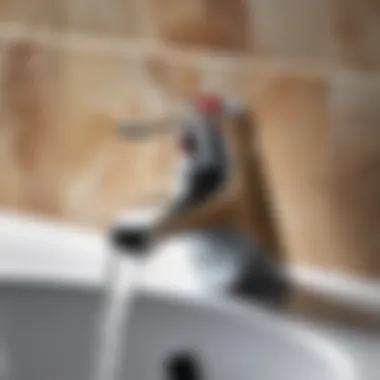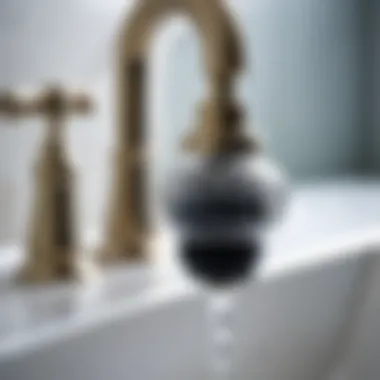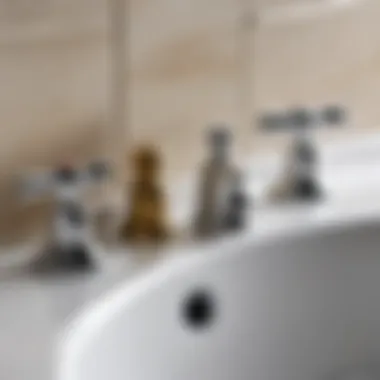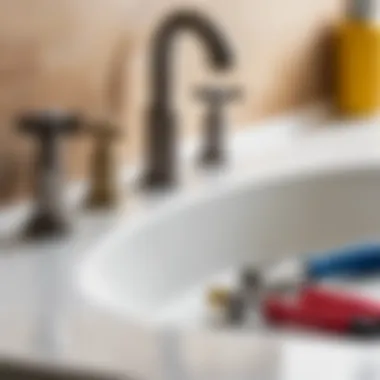Troubleshooting Bathroom Faucet Malfunctions


Intro
Dealing with faucet malfunctions in the bathroom is an experience many homeowners encounter. These issues can disrupt daily routines, leading to frustration and possible water waste. Understanding the potential causes of faucet problems can assist homeowners in diagnosing and resolving them efficiently. It is essential to approach these situations with a clear framework that enables effective troubleshooting.
This article aims to explore various common faucet malfunctions, from minor leaks to significant issues that may require professional handling. Equipped with this knowledge, readers can take informed steps toward maintaining their bathroom fixtures effectively.
Проектирование и планирование
When faced with a malfunctioning faucet, it is crucial to have a well-thought-out approach before diving into any repairs. Understanding the specific project at hand and organizing the time and resources can save considerable headaches down the line.
Как выбрать проект для DIY
Selecting the right project revolves around identifying the symptoms exhibited by the faucet. Possible signs of malfunction include:
- Leaking or dripping water
- Inconsistent water pressure
- Strange noises when operating the faucet
- Water discoloration
Once you recognize the specific issue, you can delineate whether it falls within your capacity for a DIY repair or if it is better suited for a professional plumbing service. This assessment can streamline your efforts and resources accordingly.
Оценка времени и ресурсов
Evaluating the time required for the repair is equally important. Some tasks might take only minutes, such as replacing a washer, while others involving more extensive plumbing work could demand several hours or even days. Consider listing the necessary tools and materials based on the project you have selected. Common tools needed often include wrenches, screwdrivers, and perhaps a basin wrench for harder-to-reach areas.
By preparing ahead and being organized, you can minimize frustration and enhance the efficiency of your repair efforts.
Выбор материалов
Choosing appropriate materials is a crucial aspect of faucet repairs. The effectiveness and longevity of the repair depend greatly on the quality of the materials used.
Типы материалов для различных проектов
Some common materials you may need include:
- Washers and O-rings: These are essential for leaks.
- Pipe joint compound: Useful for sealing threaded connections.
- Replacement cartridges: Needed for cartridge faucets.
Understanding the different types of faucets—compression, cartridge, ball, and ceramic disc—can also guide your selection of replacement parts.
Советы по покупке и экономии
When purchasing materials, consider the following:
- Buy from reputable suppliers to ensure quality.
- Compare prices across vendors and look for discounts.
- Sometimes, buying a complete repair kit can be more economical than purchasing individual parts.
The proactive approach of choosing quality materials paired with diligent planning enables effective repairs. This lays the foundation for a functional and efficient bathroom faucet, ultimately enhancing home maintenance.
Intro to Faucet Malfunctions
Faucets are essential components in any bathroom. They provide the necessary water to carry out daily tasks such as washing hands, brushing teeth, or filling the tub. Understanding faucet malfunctions is crucial for maintaining not only the functionality of these fixtures but also the integrity of the overall plumbing system in a home. A malfunctioning faucet can lead to water wastage, increased utility bills, and damage to surrounding areas. Therefore, addressing faucet issues promptly is important.
Importantly, being aware of the specific concerns related to faucet performance can save time and resources. Recognizing when a faucet is not functioning correctly allows homeowners and DIY enthusiasts to act quickly. This can prevent minor issues from evolving into significant repairs that require professional intervention.
Importance of a Functional Faucet
A functioning faucet impacts everyday life. A reliable faucet provides convenience and comfort. When a faucet operates properly, it ensures adequate water flow and temperature control. This is especially relevant in bathrooms, where hygiene is of utmost importance. An efficient faucet contributes to a pleasant experience, be it a morning routine or a soothing bath in the evening.
In contrast, a malfunctioning faucet can disrupt this comfort. Issues such as leaks or lack of water flow can create frustration and inconveniences. Moreover, ineffective faucets can lead to larger plumbing problems if left unattended. Therefore, maintaining a functional faucet is not just about comfort; it prevents potential costly repairs down the road.


Common Signs of Faucet Failure
Recognizing the signs of faucet failure early can mitigate larger issues. Common symptoms include:
- Dripping or leaking: Continuous dripping is often a sign of worn washers or deteriorating seals.
- Low pressure: If the water trickles instead of flows steadily, it may indicate clogs or pressure issues.
- Strange noises: Unusual sounds while running water can suggest air in the lines or something obstructing the faucet.
- Temperature problems: If the faucet does not mix hot and cold water correctly, it can be a sign of internal issues.
Understanding these signs provides a clear pathway to identify when a faucet needs attention. Recognizing the early stages of faucet failure allows for swifter action and repairs.
Types of Faucet Issues
The proper functioning of a faucet is crucial to bathroom usage. When issues arise, they can affect comfort and convenience. Understanding the types of faucet issues can help you identify what might be wrong and how to address it.
No Water Flow
Water flow issues can be frustrating. A faucet that does not dispense water may indicate a significant blockage or a problem with the supply line. It is essential to determine whether other fixtures in the bathroom are affected. If the entire faucet fails to produce water, start by checking for closed valves. If everything is operational but the faucet still lacks flow, sediment buildup or a clogged aerator may be the cause. Regular maintenance can prevent these situations from arising.
Leaking Faucets
Leaks can contribute to higher water bills and water wastage. A faucet leak might stem from several causes, including a faulty washer or corroded components. When examining a leaking faucet, first check whether the leak is pervasive. You may notice it from the spout or handle. Repairing a leak is often straightforward. Replacing worn-out washers or O-rings usually resolves the issue. Sometimes, a more significant problem lies within the faucet assembly itself, requiring deeper inspection.
Low Water Pressure
Low water pressure can signal plumbing troubles. When the water flow is weak, it may result in frustration during day-to-day tasks. In some instances, it may be localized to a single faucet, indicating specific issues with that fixture. Possible causes include valve problems, mineral deposits, or a faulty pressure regulator. Assessing the situation often involves examining the faucet or the broader plumbing system to get a clearer picture of the issue.
Strange Noises
Unusual sounds during faucet operation can be concerning. Sounds such as banging, whistling, or sputtering may arise during water flow. These noises can indicate problems with the faucet itself or the plumbing system. Air trapped in pipes could cause banging, while a partially open valve might create whistling. Identifying the source of these sounds is vital, as they can point to air locks or even significant issues in your plumbing, requiring prompt attention.
A prompt diagnosis of faucet issues can save time and resources in the long run. Regular checks and maintenance can help address problems before they escalate.
Diagnosis of Faucet Problems
Diagnosing faucet problems is a critical step in maintaining your bathroom’s functionality. Understanding how to correctly identify issues contributes to minimizing repair costs and reducing frustration. Many faucet malfunctions stem from simple mistakes or overlooked factors. Knowing how to effectively diagnose them means less time spent on incorrect assumptions and more efficient troubleshooting. In this section, we will explore a systematic approach to identify the source of faucet issues, which will help in making informed decisions about repairs.
Step-by-Step Troubleshooting
Check Water Supply
The first action in troubleshooting a faucet problem is to check the water supply. This is essential because many faucet failures arise from a lack of water pressure or a complete cutoff. A key characteristic here is the simplicity of this step. It is usually a straightforward process; simply ensure that the shut-off valves under the sink are fully opened. Addressing water supply issues can save time and reduce the likelihood of unnecessary repairs to the faucet itself. One unique feature of this diagnostic step is that it often is the least suspected cause, leading homeowners to overlook it. The significant advantage of checking the water supply first is the clear and quick resolution that comes from it.
Inspect for Clogs
The next sensible step is to inspect for clogs in the faucet or the pipes. Clogs can arise due to mineral deposits, debris, or even food particles, which disrupt the flow of water and lead to various malfunction symptoms. This method is particularly effective because many problems stem from such simple blockages. A crucial benefit of this inspection is that it can easily reveal issues leading to low water pressure or intermittent flow problems. The unique benefit of this inspection is its ability to be done without advanced equipment. Additionally, addressing clogs can restore water flow without the need for costly repairs or part replacements.
Test Temperature Controls
Lastly, testing the temperature controls is vital for diagnosing faucet issues. Problems with temperature can often lead to user dissatisfaction and signal more complicated underlying issues. The key characteristic here is the direct impact on user experience; an ineffective temperature control makes using the faucet frustrating. This step is beneficial because it directly affects comfort and usability. A unique aspect of testing these controls is that it can quickly lead to identifying if the problem lies with the faucet itself or the plumbing system beyond it. Evaluating temperature controls allows a thorough understanding of how the faucet system operates and can pinpoint issues that might require more extensive access to plumbing.
Common Tools Needed for Diagnosis
For effective diagnosis, certain tools become necessary.
Wrench
A wrench is an essential tool when diagnosing faucet problems, particularly when needing to remove parts for closer inspection. Its primary characteristic is versatility; it can fit various sizes of nuts and bolts found in different types of faucet fixtures. A wrench is a beneficial choice in this article because it allows access to the inner workings of the faucet. Its unique features include adjustable sizes, making it adaptable for different plumbing requirements. The disadvantage may be that improper use can lead to damaging fixtures, so readjusting for the right size is important.


Screwdriver
A screwdriver also serves a critical role in the diagnosis of faucet problems. Used for loosening screws on faucet assemblies, it’s a straightforward yet vital tool for opening or securing parts during inspection. The key characteristic of a screwdriver is its universal nature; most faucets will have screws that require this tool. Its beneficial nature lies in the simple use without needing advanced plumbing skills. However, the unique downside is that without the right type of screwdriver (e.g., Phillips vs. flathead), you may struggle to open the faucet, complicating the diagnostic process further.
Plumber's Tape
Also known as Teflon tape, plumber's tape aids in preventing leaks during repairs. This tool is crucial after repairs to ensure that fittings are secure. The key characteristic is its ability to provide a waterproof shield, enhancing the reliability of the faucet once parts are replaced. It is popular in this context for offering a simple solution that requires minimal effort. A unique feature is that it is inexpensive and widely available, making it accessible for most homeowners. The downside is that if applied incorrectly, it can lead to leaks, which would require further work to correct.
Effective diagnosis can save time, money, and frustration. Knowing the right steps can prevent unnecessary repairs and maintain your faucet's life.
Possible Causes of Faucet Problems
Understanding the possible causes of faucet problems is essential for both DIY enthusiasts and professionals in the construction and interior design sectors. Recognizing these issues early influences the effectiveness of repairs and helps in preventing further damage. A malfunctioning faucet could stem from multiple factors, and pinpointing the exact cause can save time and money. Addressing these issues promptly can maintain the overall functionality of your plumbing system, thus preventing more significant problems down the line.
Mineral Buildup
Mineral buildup occurs when water, especially hard water, leaves deposits over time. These deposits can accumulate inside the faucet mechanisms, leading to reduced water flow and pressure. If you notice a slow drip or irregular water distribution, mineral buildup is likely the culprit.
Signs of mineral buildup include:
- Reduced water flow from the faucet
- Noticeable white or chalky residues around the spout
To address this, periodic cleaning using distilled white vinegar can dissolve these minerals. For severe clogs, a more thorough disassembly of the faucet may be required to clean the components directly. Immediate attention to this issue is advisable to avoid more extensive repairs later.
Worn-Out Washers
Washers are vital components within faucets, providing a secure seal to prevent leakage. Over time, these washers can wear out due to constant friction and pressure. If you observe consistent dripping or leaking from your faucet, worn-out washers should be your first suspects.
Common symptoms of washer issues include:
- Dripping water from the faucet
- Water leaking from the handle
Replacing washers is a relatively straightforward process and typically involves turning off the water supply, disassembling the faucet, and swapping out the old washer for a new one. It is important to use the correct size and type of washer for your specific faucet model.
Corroded Parts
Corrosion in faucets often results from prolonged exposure to moisture and minerals present in the water. This corrosion can hinder the faucet's functionality and may lead to leaks or interruptions in water flow. If your faucet has visible signs of rust or if water leaks appear from these areas, corrosion may be the cause.
Consequences of corroded parts include:
- Increased risk of leaks
- Compromised water quality
In most cases, corroded parts should be replaced entirely. Attempting repairs on corroded materials may not be effective and can lead to further complications. Regular inspections can help you catch such issues before they escalate.
Improper Installation
An incorrectly installed faucet can lead to a host of problems, from minor leaks to complete system failures. If you experience problems soon after installation, this could be a sign that something was not fitted correctly. Consider variables such as alignment, improper sealing, or use of incorrect parts.
Indicators of improper installation may include:
- Leaks at the base of the faucet
- Uneven water pressure
If you suspect installation issues, it may be necessary to review the installation process or consult the manufacturer's guidelines. In some cases, bringing in a qualified plumber to evaluate and correct installation mistakes may be the best course of action to ensure long-term functionality.
DIY Solutions for Common Problems


Exploring DIY solutions for faucet issues is key in this article, as many homeowners prefer to tackle repairs without hiring professionals. Understanding how to fix common problems not only saves money but also empowers individuals. Simple tasks, like cleaning and part replacement, can prevent bigger issues from arising. It also enhances the longevity of the faucet.
Cleaning Faucets
Using Vinegar for Mineral Deposits
Using vinegar for cleaning mineral deposits is effective. Vinegar's acidic nature breaks down hard water stains that accumulate over time. This method is highly regarded because it is an easy process. A key characteristic of vinegar is its availability; most households already have it.
The unique feature of using vinegar is the non-toxic element. It is safe for both household use and the environment. The advantage is that it can restore faucets to a cleaner state without the need for commercial cleaners, which can contain harsh chemicals. However, one disadvantage to consider is that stubborn deposits may need several treatments or more aggressive cleaning solutions.
Cleaning Aerators
Cleaning aerators is essential when addressing faucet flow issues. Aerators can become clogged with debris and sediment. Regular cleaning ensures optimal water flow and efficiency. A key characteristic of cleaning aerators is simplicity; it typically involves unscrewing the aerator and rinsing it.
The unique benefit of this method is that it prevents water pressure problems and extends the lifespan of the faucet. One downside is that sometimes, the components within the aerator may be damaged. In such cases, replacement rather than cleaning is necessary to maintain efficiency.
Replacing Worn Parts
Identifying Required Parts
Identifying required parts is an important step in faucet maintenance and repair. It involves knowing what components need replacement, such as washers, seals, or cartridges. This is beneficial for ensuring that repairs effectively tackle the root of the problem. The key aspect here is observation; recognizing wear and tear early can prevent larger malfunctions.
The unique feature of this aspect is the ability to source parts easily, both online and in local hardware stores. Their availability makes this DIY approach popular. The advantage is that buyers can often find affordable parts, thus saving money on repairs. However, there might be a disadvantage if the wrong part is ordered or identified, leading to failure in fixing the faucet.
Replacement Process
The replacement process of faucet parts is critical for restoring functionality. Knowing the right steps ensures that the replacement is successful. A key characteristic is that this process typically requires a few basic tools, such as wrenches and screwdrivers.
The unique benefit of this process is that it is often straightforward and can usually be completed within an hour or two. Clear instructions can help individuals navigate it effectively. Yet, one advantage to consider is that if there are underlying issues not addressed, replacing parts may only be a temporary fix. Over time, further complications may arise without proper diagnosis.
The End and When to Call a Professional
Addressing faucet malfunctions in the bathroom is not just a matter of convenience; it's essential for maintaining efficient plumbing and preventing more extensive problems down the line. This section emphasizes the importance of understanding the severity of issues when they arise. Recognizing whether a faucet problem is a minor inconvenience or a sign of a larger plumbing issue can help homeowners make informed decisions about repairs versus professional interventions.
Assessing the Severity of the Issue
When encountering a malfunctioning faucet, a careful assessment is crucial. Start by determining if the problem is isolated to one faucet or if multiple fixtures are affected. Is there a persistent leak, or do you notice water pooling around the base?
- Check if the leak is small or significant. A minor drip may mean replacing a washer, while a more significant leak could indicate pipe issues.
- Evaluate pressure changes. Sudden drops in water pressure could point to a blockage elsewhere in the plumbing system.
- Consider unusual noises. Sounds such as hissing or banging might indicate air in the pipes or issues with valves.
Taking these factors into account can inform whether you need a quick repair or a more comprehensive evaluatioon.
Finding a Qualified Plumber
When a faucet problem exceeds the scope of DIY repairs, finding a qualified plumber becomes essential. A professional can provide expertise to properly diagnose issues and perform repairs needed.
Recommendations and Reviews
Searching for reputable plumbing services often starts with recommendations and reviews. Peer feedback offers insights about service quality. Positive reviews indicate reliability, while negative feedback can highlight potential pitfalls.
- Look for local plumbing companies with a strong reputation in the community.
- Check online platforms for reviews—sites like Reddit and Facebook can provide candid opinions from homeowners.
This approach fosters informed choices, ensuring selections align with individual needs.
Expected Costs
Understanding expected costs of hiring a plumber can guide budgeting and planning. Most plumbers charge a service fee plus parts and labor. Rates may vary based on:
- The geographical location
- The complexity of the issue
- The plumber's experience level
It's prudent to gather estimates from multiple sources to avoid overspending. However, do not solely choose the cheapest option; ensure skill level and service quality meet your requirements.







